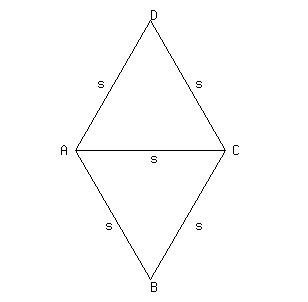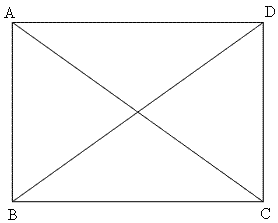8th Grade > Mathematics
PRACTICAL GEOMETRY MCQs
:
B and D
As no angles are given, we need to know all three sides to construct a triangle. Thus, triangle ADC and ABD cannot be constructed as first step because side AD’s length is not known.
:
A
A quadrilateral is made up of two triangles. Diagonal is the common side for both the triangles. If all the four sides and a diagonal is known, then we can construct a quadrilateral by constructing two triangles. The two triangles are constructed using SSS property.
:
B and C
The line segment for which both the angles are given should be drawn first. For e.g. in the case of line segment MI, both angles M and I are known. Similarly, for IS, the angle I and S are known. Thus, either MI or IS can be drawn, because angles at both end points of both line segments are known.
:
A
Sum of the two sides of the triangle is greater than 3rd side
let, 1st side be a=2, 2nd be b=3, 3rd be c.
As per above condition,
a+b>c ⇒ 2+3>c ⇒ c<5
a+c>b ⇒ 2+c>3 ⇒ c>1
so, 1<c<5 units
:
D
We can't draw a unique quadrilateral with all the measurements which are given. This is because we need the measurement of two adjacent sides and 3 angles to construct the quadrilateral ABCD. But with BC, we will have 6 sets of measurements and two known adjacent sides. Hence, we will be able to construct the quadrilateral ABCD.
:
A
If we have the measures of all the sides of a quadrilateral and its one diagonal, we can draw two triangles and hence, form a quadrilateral.
ABCD comprises of two triangle △ ADB & △ CDB
In Δ ADB, AB = 3cm, BD = 8cm, and AD = 4cm
Since, AB + AD < BD
△ ADB can't be constructed.
So, quadrilateral ABCD can't be constructed.
:
C
Measurement of all the sides or 2 angles and 1 side or 1 angle and 2 sides are required to construct a unique triangle. Using 3 angles, we can construct many triangles, not a unique triangle. For e.g. there are infinite equilateral triangles though they have all the angles equal to 60∘.
:
D
Step1: Draw rough diagram of the parallelogram ABCD
Here, ∠ DAC = ∠ ACB= 15∘ - (1) (Alternate interior angles)
In △ ABC,
∠ A + ∠ B + ∠ C must be 180∘
∠ A + ∠ B + ∠ C = 25∘ + 110∘ + 15∘ (from (1))
∠ A + ∠ B + ∠ C = 150∘
The sum of angles in a triangle should always be equal to 180∘. So, this construction is not possible.


















